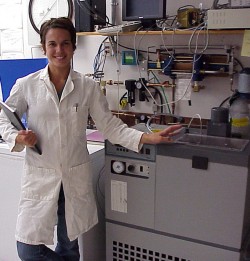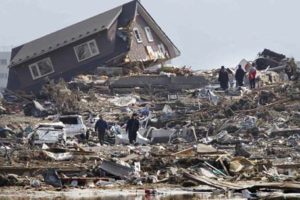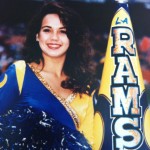 Meet Christine, a former cheerleader for the NFL Rams who is now a research postdoc at Columbia University’s earth science Institute. Science Cheerleaders, Christine, Amanda, and Rachel will be at the World Maker Faire in NY, 9/17-9/18 demonstrating how to extract DNA from strawberries. They’ll also join forces with our sister site, Science For Citizens, and Discover Magazine to encourage people to do citizen science activities. [Updated 1/1/14]
Meet Christine, a former cheerleader for the NFL Rams who is now a research postdoc at Columbia University’s earth science Institute. Science Cheerleaders, Christine, Amanda, and Rachel will be at the World Maker Faire in NY, 9/17-9/18 demonstrating how to extract DNA from strawberries. They’ll also join forces with our sister site, Science For Citizens, and Discover Magazine to encourage people to do citizen science activities. [Updated 1/1/14]
Science Cheerleader (SC): Before we talk about your cheerleading days, I’d like to start with something more serious. You were in Japan when the horrific earthquakes set loose. Why were you in Japan and what was that experience like for you?
Christine: After I completed my Ph.D. in the Spring of 2009, I went to Japan for a two-year post-doctoral research position. I was working at the Earthquake Research Institute, which is part of the University of Tokyo. My boss was a Japanese scientist who received funding to investigate something called “seismic attenuation”. Since we cannot dig more than a few kilometers deep, our only way of knowing what the earth looks like on the inside is by examining the way seismic waves travel through it. But, in order to understand the seismic waves, seismologists need to know how waves travel through different kinds of features, for instance melted rock versus solid rock. In particular, they need to know how the energy of the wave is damped out, or attenuated. My boss and I conducted experiments to measure wave attenuation in rocks at different temperatures and grain sizes and also with small amounts of melted rock inside the samples.
I was there at work on March 11th. It was terrifying. I grew up in Southern California where there are also a lot of earthquakes. When you live in a geologically active part of the world you are always aware that something like that can happen at any time. Growing up, we would regularly have earthquake drills, where we had to duck under our desks and then proceed outside to safety. That being said, nothing really could have prepared me for how big the March 11th quake was. My office mates and I ran down the stairs and waited in the parking lot while the earthquake continued for what seemed like five minutes. While I waited for it to stop, I distinctly remember trying to stay nimble and ready to leap and run in case the ground opened up in front of me. The motion was large enough that I actually considered that to be a realistic possibility. There were many very strong aftershocks in the days and weeks following the main quake that were equally frightening because there was the looming fear that even larger quakes on nearby faults might occur.

Japan Earthquake, Tsunami AP, The Yomiuri Shimbun
SciCheer: What happened to the earth?
Christine: The surface of the earth is broken up into tectonic plates which move around slowly. All the exciting and dangerous geology occurs on the margins of the plates, where they interact with each other. In some locations, two buoyant plates crash into one another and create mountains, like the Himalayas. In other locations, one plate sinks under the other plate, creating volcanoes and earthquakes. All along the perimeter of the Pacific Ocean, the oceanic plate is dipping underneath the various continental plates, creating the so called “Ring of Fire”. Every time the oceanic plates moves downward we feel an earthquake. Often this motion will occur offshore, underneath the ocean. At the moment the oceanic plate moves, it bends the edge of the continental plate down with it a little bit. Then the continental plate will bounce back up. It is that bouncing back motion that quickly displaces a huge volume of water, creating a wave that may turn into a tsunami. It was the tsunami that did the majority of the damage in Japan. Since the region is well know for earthquakes, Japanese engineers and architects spent a lot of time creating strong buildings that will sway smoothly even with incredibly large earthquake motion. Thanks to their ingenuity, there was very little damage from the earthquake itself. However, something very complicated happened on the sea floor when the continental plate bounced back up. Scientists are still trying to figure out the dynamics that caused a far greater displacement of water than was predicted, creating the devastating amount of damage to the coastal regions of Japan.
SciCheer: What turned you on to science and when?
Christine: Having grown up in one of those geologically exciting places of the earth, I was regularly exposed to earthquakes and dynamic mountain regions. However, it wasn’t until I retired from dance in my mid-twenties and began rock climbing that I really fell in love with geology. During a rock-climbing trip to Colorado, I remember seeing some specific features (a meandering stream with an oxbow lake) that were exactly like the pictures I had seen in my “rocks for jocks” class in college. Everything I had learned about how they were formed came flooding back to me and I started rambling on about it to my friends, who thought I had suddenly been possessed. On a later trip, I remember hanging from a belay high above Yosemite valley and being able to completely imagine the glacier that carved its way through the granite to make those beautiful exposed faces. Geology just made sense to me in this very real and tactile way. Even though I already had a career as a paralegal at the time, I decided then and there to quit my job and go back to school to learn everything I could about geology. At that point I decided that even if I never made a career of being a geologist, I would still be satisfied to have enriched my life by this knowledge. So I went for it.
SciCheer: What did you study in college?
Christine: Since my first undergraduate degree was in communications (B.A.), I had to go back for a second undergraduate degree (B.S.) covering all the physics, chemistry and calculus that I had missed. I finished the B.S. in two years at the University of Oregon (go Ducks!) I then went to grad school at Brown University, earning my masters and my doctorate in geological science. During my time at Brown I realized that even though I liked being outside with natural rocks, I loved being inside doing experiments. I really like the physical aspect of making samples with my own two hands and then torturing them in some way (squeezing the rocks or pulling on them or even “tickling” them with tiny waves) and watching how they respond.
 SciCheer: Which team did you cheer for and when?
SciCheer: Which team did you cheer for and when?
Christine: I cheered for the Los Angeles Rams, which tells you a little bit about how old I am because they have been in St. Louis for some time now. This was 1991 and 1992.
SciCheer: What prompted you to try out?
Christine: During my undergraduate (the first time) I was on my college dance team. During the four years I was there, we were National Champions twice and placed second twice. I was devoted to my team and I absolutely adored my coach, Rey Lozano. Sometime before my junior year, he was hired as the choreographer for the L.A. Rams. Though cheering for a pro football team was not something I had considered, being able to work more with Rey was motivation enough for me to tryout. I cheered with them for two years, during my Junior and Senior years of college.
SciCheer: Which came first? Your interest in science or cheerleading?
Christine: Definitely cheerleading. For better or for worse, my interest in dance at that time was all-consuming. It was only after I retired from dancing that I started to look around and see the larger world out there.
SciCheer: Can you describe a typical day at work/school?
Christine: One of the things I like best about my job is that it can vary significantly from day to day. I can shuffle between making samples and running experiments in the lab or chatting with colleagues over coffee or sitting in my office reading and writing scientific papers.
SciCheer: Did you find that stereotypes about cheerleaders helped or hindered your studies or professional experiences? (Were you taken seriously?)
Christine: A little of both. Based on the advice of a mentor, I listed my cheerleading experience on my application to graduate school. Although I think that my “interesting story” and circuitous path to science may have helped me get into Brown, which prides itself on accepting “non-traditional” students, it may not have endeared me to my fellow classmates. One of the professors who read my application told one of his students who then spread it all around. So before I even arrived, the hallways were atwitter with news of this pro cheerleader and all of the stereotypes associated therewith.
SciCheer: Can you elaborate on this email you sent to me (which I LOVE)?
“When I first started studying science I was a little embarrassed about my cheerleading past. But as my enthusiasm and energy came through in my conference talks and in classes that I taught, I realized that a little bit of spirit is exactly what science needs.” Can you share examples?
Christine: Continuing from above, in the beginning of graduate school I tried to counter the expectations that people had about a pro cheerleader by being as plain (in appearance) and as sedate and serious (in personality) as I could possibly be. But as I grew more and more confident that I could keep up just fine with all of my colleagues in the classroom, I let myself relax a little. I experience pure joy sometimes in the lab and I am no longer embarrassed to let out a loud woop or clap wildly if something goes particularly well, say a broken machine comes back to life after some tinkering.
I also particularly enjoy giving presentations at conferences. The experience is remarkably similar to performing in a competition. I prepare my PowerPoint slides, paying attention to the order and flow of the information (like choreographing a routine) and then I practice it over and over again, getting it just perfect. I even get the butterflies and have trouble sleeping the night before. I think that my experience performing provides a distinct advantage for me in this area.
SciCheer: How did your fellow cheerleaders accept your interest in science?
Christine: Since my interest in dance was rather myopic at the time, they were quite shocked to hear the news. Those who knew me at the time I was making the transition were rather incredulous, and rightly so, that someone could possibly decide one day in their late twenties to become a scientist. There was at first a lot of “Yeah, good luck with that.” Then I dropped off the face of the earth for eight years. Now when I see old friends, they think it is a little crazy that I am a “rock doctor”, but they accept it and give me big props for actually pursuing my dream.
SciCheer: Do you have any advice for youngsters who might feel torn between following one dream (cheerleading, etc) and following another (a STEM career)?
Christine: Don’t choose; do both! Although I focused on one exclusively and then the other, it would have been far more efficient to pursue both areas of interest simultaneously. And in fact, skills learned in one field can be applied and used to your advantage in the other.
SciCheer: Along these lines, what advice would you give your 12-year-old self?
Christine: I would give myself the above advice. I showed academic promise at an early age, but I let that side of myself go dormant somewhat when I started to really excel at dance. If I could do it all again I would have pursued both actively. It certainly would have shaved several years off the process if I didn’t have to go back for a second bachelor’s degree. But the nice thing is that I could. Not a lot of countries allow someone to have a drastic career change like that in their twenties. I was truly lucky to have the opportunity and I encourage everyone to follow their dreams no matter how crazy they may seem. It’s never too late. I would tell my 28-year-old self that it will all be okay. Quitting my job to go back to school and incur a pile of debt and be away from my friends and family for all those years was terrifying and many times I doubted myself. But today I go to work every day with a smile on face. I absolutely love what I do and it was worth every minute of it.
SciCheer: What are your plans for the future?
Christine: I’m currently living in New York City and have my dream job as a research postdoc at Columbia University, at their earth science Institute (Lamont-Doherty). The position is for two years, but hopefully if I do well I can transition into a permanent Research Scientist position in the future. I had a baby girl this summer [2013] and have been on a leave of absence to care for her. Other than that, I am still a postdoc at Columbia and still hoping to stay on permanently if I can.
Learn more about Christine on her personal website.

